Are you new to the world of cheese boards? Don't worry, you're not alone! Many people find themselves overwhelmed when it comes to creating a cheese board for the first time. However, with a few tips and tricks, you can create a beautiful and delicious cheese board that will impress your guests (or just yourself!).
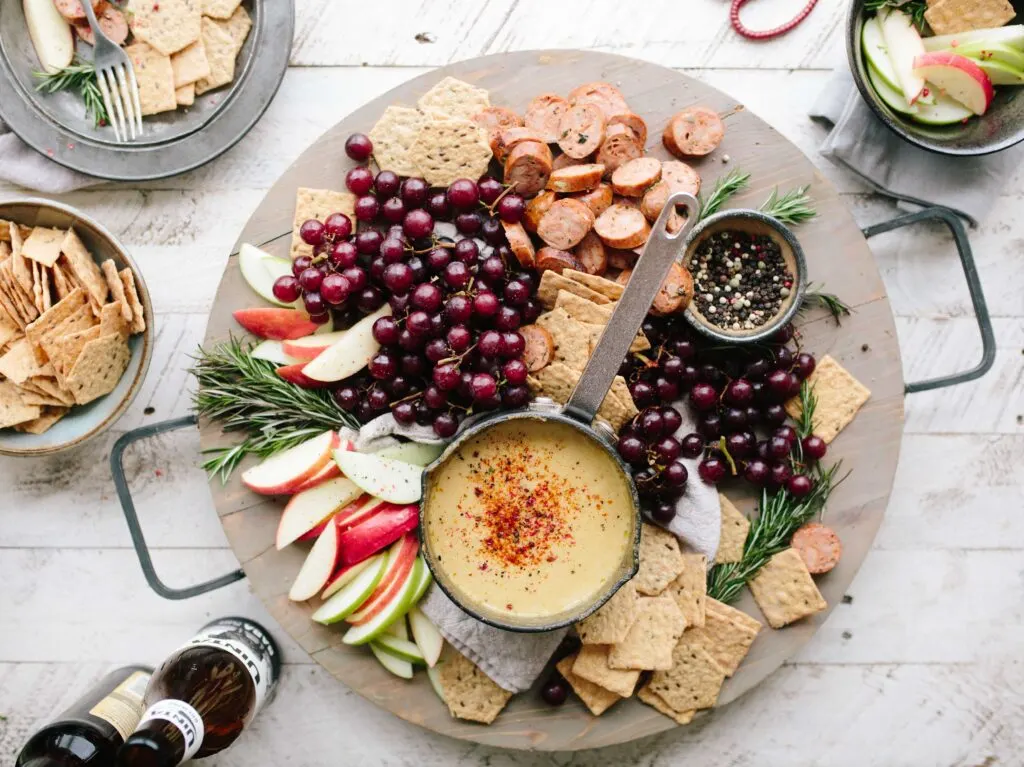
First, let's talk about the basics. A cheese board typically consists of a variety of cheeses, crackers or bread, and accompaniments such as fruits, nuts, and spreads. When selecting cheeses, it's a good idea to choose a variety of textures and flavors. You might want to include a soft cheese like brie or camembert, a hard cheese like cheddar or parmesan, and a blue cheese like gorgonzola or roquefort.
Now, let's talk about some easy cheese board ideas for beginners. One simple approach is to create a theme for your cheese board. For example, you could choose all French cheeses and pair them with a baguette and some grapes. Another idea is to create a color scheme, such as all white cheeses with white crackers and white fruits like pears and apples. Don't be afraid to get creative and have fun with it!
Cheese Board Ideas for Beginners: Easy and Delicious Options to Try
Choosing the Right Cheese Board
When it comes to creating a perfect cheese board, choosing the right cheese board is just as important as selecting the right cheese. The cheese board serves as the foundation for your cheese display and can elevate the presentation of your cheese selection. In this section, we will discuss the types of cheese boards and how to select the right size and material for your cheese board.
Types of Cheese Boards
There are several types of cheese boards available, and each has its unique style and function. Here are some of the most popular cheese board types:
- Wooden Cheese Board: A classic choice, a wooden cheese board is versatile, durable, and provides a warm and rustic look. It is perfect for serving a variety of cheese types, and its natural texture makes it an excellent choice for displaying different textures and shapes.
- Marble Cheese Board: A marble cheese board is an elegant choice that provides a sleek and modern look. It is perfect for serving hard and soft cheeses and keeps the cheese cool for an extended period.
- Slate Cheese Board: A slate cheese board provides a unique and contemporary look, and its dark background makes the cheese colors pop. It is perfect for serving a variety of cheese types and can be personalized with chalk.
Selecting the Size and Material
When selecting the size and material of your cheese board, consider the number of guests you will be serving and the types of cheese you will be displaying. Here are some tips to help you choose the right size and material:
- Size: Choose a cheese board that is large enough to accommodate all the cheese you want to display, but not so large that it overwhelms your table. A good rule of thumb is to select a cheese board that is at least 12 inches in diameter.
- Material: Consider the texture and shape of the cheese you will be serving when selecting the material of your cheese board. A wooden cheese board is perfect for serving a variety of cheese types and showcasing different textures and shapes. A marble cheese board is ideal for serving hard and soft cheeses and keeping the cheese cool. A slate cheese board is perfect for serving a variety of cheese types and showcasing different textures and shapes.
In conclusion, selecting the right cheese board is an essential part of creating a perfect cheese board. Consider the types of cheese boards available, and choose the size and material that best suits your needs. With the right cheese board, you can elevate the presentation of your cheese selection and impress your guests.
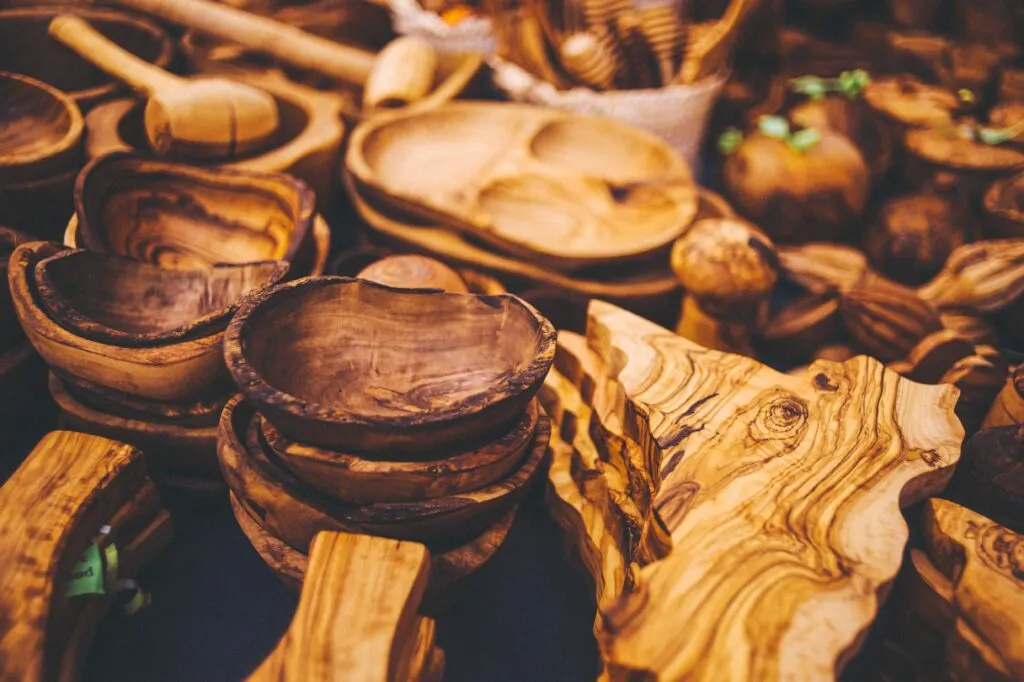
Essential Cheeses for Your Board
When it comes to creating a cheese board, choosing the right cheeses is crucial. As beginners, we want to make sure we have the essential cheeses covered. Here are the four main categories of cheese that we recommend, along with some of our favorite options.
Soft Cheeses
Soft cheeses are creamy and spreadable, making them a crowd-pleaser. One of our favorites is Brie, a French cheese with a mild, buttery flavor and a soft, edible rind. Another great option is Camembert, which is similar to Brie but has a slightly stronger flavor. Goat cheese is another popular choice, with its tangy, slightly acidic taste.
Semi-Soft Cheese
Semi-soft cheeses have a firmer texture than soft cheeses, but are still creamy and easy to spread. One of our go-to options is Gouda, a Dutch cheese with a nutty, caramel-like flavor. Another great choice is Manchego, a Spanish cheese with a slightly salty taste and a buttery texture. Mozzarella is another popular semi-soft cheese, with its mild, milky flavor and stretchy texture.
Hard Cheese
Hard cheeses are firm and crumbly, with a sharp and intense flavor. Parmesan is a classic hard cheese that is perfect for grating over pasta or salad. Asiago is another great option, with its nutty, slightly sweet flavor. Gruyere is a Swiss cheese that is perfect for snacking, with its nutty, slightly sweet flavor and firm texture.
Blue Cheese
Blue cheese is a type of cheese that has had Penicillium cultures added to it, which give it a distinctive blue or green mold. Stilton is a classic English blue cheese with a crumbly texture and a strong, tangy flavor. Roquefort is a French blue cheese with a creamy texture and a sharp, salty taste. Gorgonzola is an Italian blue cheese with a milder flavor and a creamy texture.
By including a selection of cheeses from each of these categories, we can create a well-rounded cheese board that will appeal to a variety of tastes.
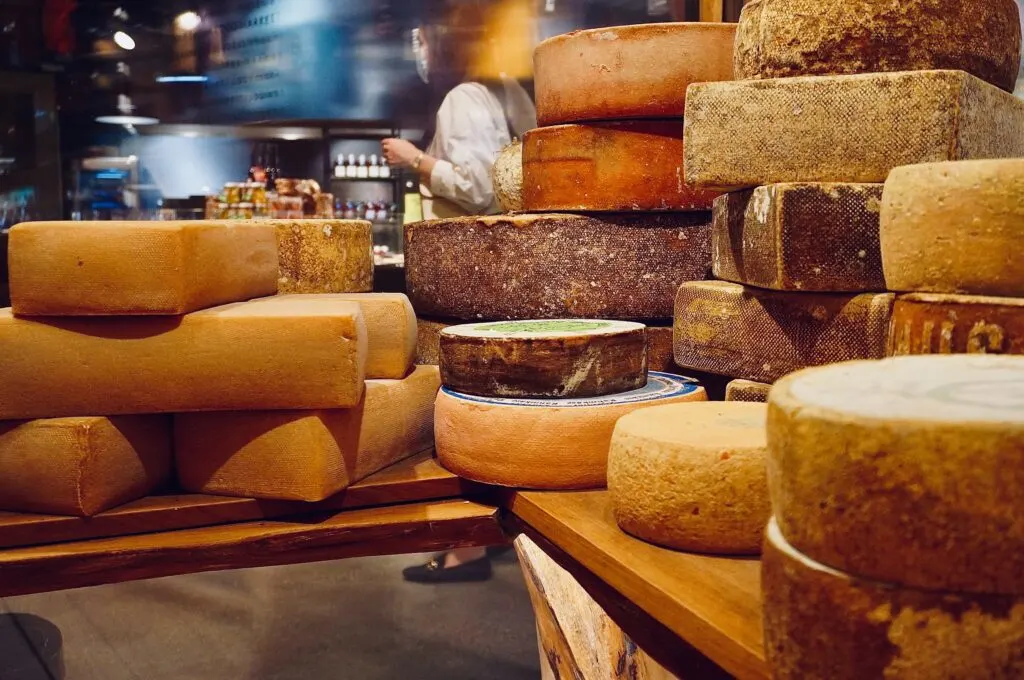
Meats and Charcuterie
When it comes to creating a cheese board, selecting the right cured meats is just as important as selecting the right cheeses. Here are some tips for selecting and arranging meats for your cheese board.
Selecting Cured Meats
When selecting cured meats for your cheese board, it's important to choose a variety of flavors and textures. Salami, prosciutto, and mortadella are all great options that pair well with a variety of cheeses. Consider choosing meats with different levels of saltiness and spiciness to add variety to your board.
When selecting meats, it's also important to consider the size and shape of the meat. Smaller, thinner slices of meat are easier to arrange on the board and make it easier for guests to grab a slice. You can also consider rolling or folding slices of meat to add visual interest to your board.
Arranging Meats on the Board
Once you've selected your meats, it's time to arrange them on the board. Start by placing larger pieces of meat on the board first, such as prosciutto or mortadella. Then, fill in any gaps with smaller slices of salami or other cured meats.
Consider arranging meats in groups or clusters to make it easier for guests to identify and select their favorites. You can also use small bowls or ramekins to hold sliced meats and make it easier for guests to grab a few slices at a time.
Remember, your cheese board is an appetizer, so don't go overboard with the meats. A few well-chosen selections will be plenty to complement your cheeses and provide a variety of flavors and textures for your guests to enjoy.
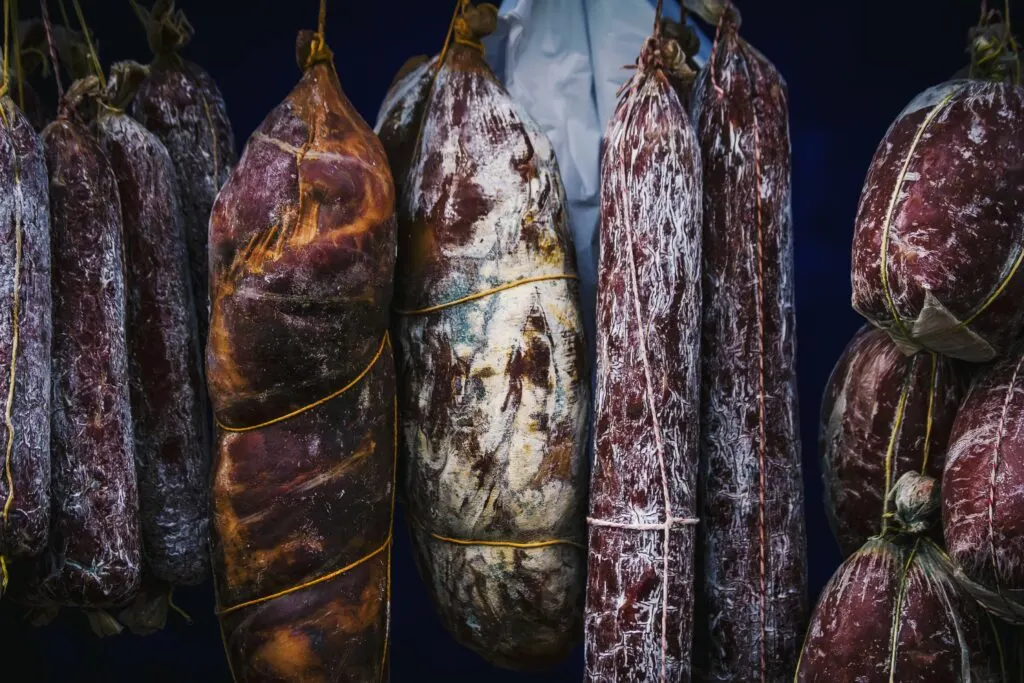
Pairing Accompaniments
When it comes to creating a cheese board, pairing accompaniments are just as important as the cheese selection itself. Here are some of our favorite pairing ideas to help you create a delicious cheese board that will impress your guests.
Fruits and Dried Fruits
Fresh and dried fruits are a great way to add some sweetness and acidity to your cheese board. We love to include a variety of fruits such as grapes, berries, apricots, and figs. Dried fruits, such as cranberries, cherries, and raisins, are also a great option. They add a chewy texture and a concentrated sweetness that pairs well with creamy cheeses like brie and camembert.
Nuts and Seeds
Nuts and seeds are a classic pairing with cheese. They add a crunchy texture and a nutty flavor that complements the creaminess of the cheese. Our favorite nuts to include are almonds, walnuts, and pecans. We also love to add some marcona almonds, which are lightly fried in oil and salted. They have a unique flavor and texture that pairs well with a variety of cheeses.
Olives and Pickles
Olives and pickles are a great way to add some saltiness and tanginess to your cheese board. We love to include a variety of olives such as kalamata, green, and stuffed. Pickles, such as cornichons and pickled vegetables, are also a great option. They add a crunchy texture and a tangy flavor that pairs well with hard and aged cheeses.
Breads and Crackers
Breads and crackers are a must-have on any cheese board. They provide a neutral base for the cheese and pairing accompaniments. Baguette slices, breadsticks, and crostini are great options for bread. Varieties of crackers such as water crackers, wheat crackers, and rice crackers are also great options. We also love to include some spreads such as honey, jam, and chutney to add some sweetness and flavor to the bread and crackers.
In conclusion, pairing accompaniments are essential to creating a delicious and well-balanced cheese board. By including a variety of fruits, nuts, olives, pickles, breads, and crackers, you can create a cheese board that will impress your guests and satisfy their taste buds.

Sweet and Savory Spreads
When it comes to cheese boards, sweet and savory spreads can really make a difference. They add a burst of flavor and texture to your cheese board and can complement the different types of cheese you've chosen. Here are a few spreads that we recommend:
Jams and Preserves
Jams and preserves are a classic addition to any cheese board. They are sweet, tangy, and pair well with almost any type of cheese. Fig jam, in particular, is a great choice as it goes well with both soft and hard cheeses. We also recommend trying apricot or raspberry preserves for a fruity and sweet addition.
Mustards and Chutneys
If you're looking for something with a kick, mustards and chutneys are a great option. Whole grain mustard is a classic choice that pairs well with sharp cheddar or gouda. For something a little different, try a spicy honey mustard or a sweet onion chutney. These spreads can add a nice contrast to the creamy texture of cheese.
To make it easier for your guests to enjoy the spreads, we recommend serving them in small dishes or ramekins alongside the cheese. This will also help keep the cheese board organized and visually appealing. Don't be afraid to mix and match different spreads to find the perfect combination for your cheese board.
Garnishes and Decor
When it comes to creating a cheese board, the garnishes and decor can make a big difference in both the appearance and taste of the board. Here are a few ideas to help you get started:
Using Fresh Herbs
Fresh herbs are a great way to add color and flavor to your cheese board. We recommend using herbs like rosemary, thyme, and basil. Simply scatter a few sprigs of herbs around the board or use them to garnish individual cheeses. Not only do they look beautiful, but they also add a fresh and fragrant aroma to the board.
Edible Flowers and Other Garnishes
Edible flowers are another great way to add a pop of color to your cheese board. Some popular options include pansies, nasturtiums, and violets. Just be sure to use only edible flowers and avoid any toxic varieties. Other garnishes to consider include sliced fruit, nuts, and honeycomb. These can add both texture and flavor to the board.
Remember, when it comes to garnishing your cheese board, less is often more. Don't overcrowd the board with too many decorations or it may become overwhelming. Instead, choose a few key elements to highlight and let the cheese be the star of the show.
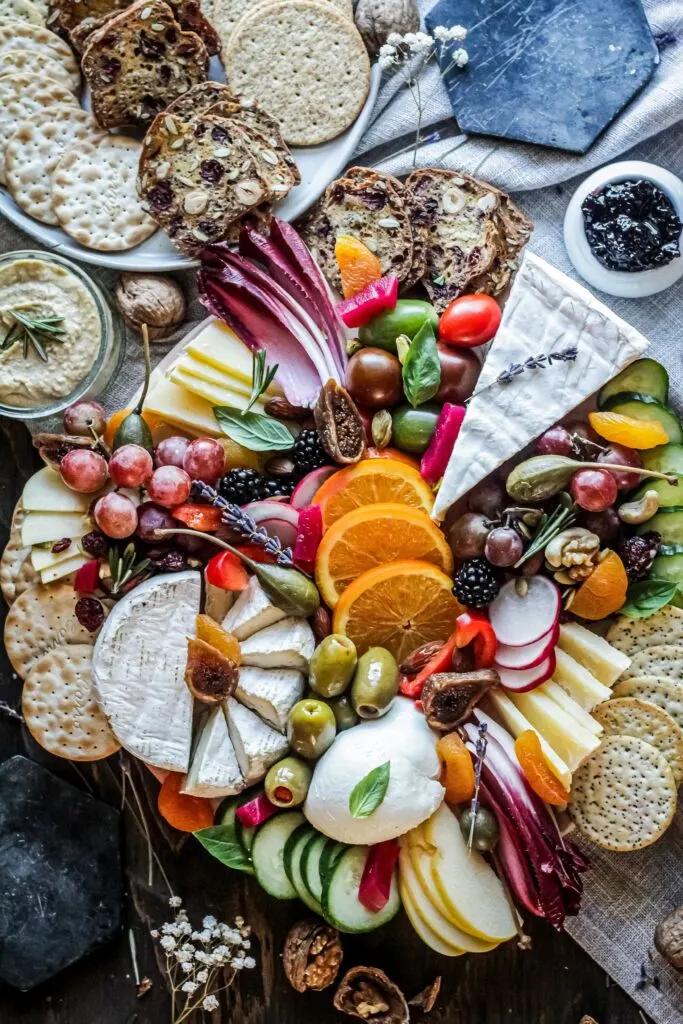
Related Post:
Assembling Your Cheese Board
When it comes to assembling a cheese board, there are a few things to keep in mind. We want to make sure that our cheese board looks visually appealing, and that we have a good variety of textures and flavors to keep our guests satisfied. Here are some tips for putting together a cheese board that is sure to impress.
Layout and Design
When it comes to laying out your cheese board, there are a few things to keep in mind. First, make sure that you have a variety of cheeses, as well as other accompaniments like crackers, nuts, and fruit. We like to arrange our cheese board in a circular or rectangular shape, with the cheeses in the center and the other accompaniments arranged around the edges.
To add some contrast and interest to your cheese board, try mixing different textures and colors. For example, you could include a soft, creamy brie alongside a sharp cheddar and a crumbly blue cheese. You could also include some fresh fruit like grapes or figs to add some sweetness and color.
Cheese Knives and Tools
When it comes to serving your cheese, it's important to have the right tools on hand. We recommend having a separate knife for each type of cheese, as well as a small spoon or spreader for any jams or spreads that you may be serving.
Cheese knives come in a variety of shapes and sizes, so it's important to choose the right one for each type of cheese. For example, a soft cheese like brie or camembert requires a different knife than a hard cheese like cheddar or gouda.
Overall, assembling a cheese board is an easy and fun way to entertain your guests. With a little bit of planning and preparation, you can create a beautiful and delicious spread that is sure to impress.

Pairing Beverages
When it comes to pairing beverages with your cheese board, there are many options to consider. Here are a few ideas to get you started:
Wine and Cheese Pairings
Wine and cheese are a classic pairing, and for good reason. The right wine can enhance the flavors of your cheese plate and vice versa. Here are some general guidelines to follow:
- Soft, creamy cheeses like brie and camembert pair well with white wines like chardonnay or sauvignon blanc.
- Hard, aged cheeses like cheddar and gouda pair well with red wines like cabernet sauvignon or merlot.
- Blue cheeses like gorgonzola and roquefort pair well with sweet wines like port or sherry.
Of course, these are just general guidelines, and you should feel free to experiment and find what works best for you. Don't be afraid to ask for recommendations at your local wine shop or grocery store.
Non-Alcoholic Options
If you prefer not to drink alcohol, there are still plenty of options for pairing beverages with your cheese board. Here are some ideas:
- Sparkling water or soda: The bubbles can help cleanse your palate between bites of cheese.
- Tea: Black teas like earl grey or darjeeling can pair well with strong, aged cheeses.
- Juice: Fruit juices like apple or grape can pair well with milder, softer cheeses.
Again, feel free to experiment and find what works best for you. The most important thing is to have fun and enjoy the flavors and textures of your cheese plate.

Shopping and Preparation Tips
When it comes to building an easy cheese board, the grocery store is your best friend. Here are some grocery store strategies that will help you create a beautiful cheese board without breaking the bank.
Grocery Store Strategies
- Shop the Sales: Check the weekly ads for deals on cheese, crackers, and other ingredients. You can often find discounts on gourmet cheeses and specialty crackers that would normally be out of your budget.
- Buy in Bulk: If you're planning on making multiple cheese boards, consider buying ingredients in bulk. This can save you money in the long run and ensure that you always have ingredients on hand for impromptu gatherings.
- Don't Be Afraid of Store Brands: Many grocery stores offer their own brands of cheese, crackers, and other ingredients. These can be just as good as name-brand products and are often cheaper.
- Ask for Help: If you're not sure what kind of cheese to buy, ask the cheese monger for recommendations. They can help you select cheeses that will complement each other and provide a variety of flavors and textures.
Prepping Ingredients in Advance
Prepping ingredients in advance can save you time and stress when it comes to putting together an easy cheese board. Here are some tips for prepping ingredients:
- Wash and Cut Fruits and Vegetables: Wash and cut fruits and vegetables a day in advance and store them in resealable bags in the fridge. This will save you time on the day of your gathering and ensure that your fruits and vegetables are fresh and ready to go.
- Slice Cheese in Advance: If you're using hard cheeses, slice them in advance and store them in an airtight container in the fridge. This will save you time and ensure that your cheese is at the perfect temperature for serving.
- Set Out Crackers and Other Dry Ingredients: Set out crackers, nuts, and other dry ingredients in advance. This will save you time on the day of your gathering and ensure that everything is ready to go.
By following these grocery store strategies and prepping ingredients in advance, you'll be well on your way to creating an easy cheese board that will impress your guests.
Frequently Asked Questions
What are some essential items to include on a beginner's cheese board?
When creating a cheese board, it's important to have a variety of textures and flavors. Some essential items to include are a mix of soft and hard cheeses, cured meats, crackers, bread, fresh and dried fruits, nuts, and spreads such as honey or jam. You can also add some vegetables like cherry tomatoes or pickles to balance out the flavors.
How can I create a budget-friendly cheese board for a small gathering?
Creating a budget-friendly cheese board is easy. Look for sales or discounts on cheese and meats at your local grocery store. You can also use crackers and bread that you already have in your pantry. Fresh fruits like grapes or apples are affordable and add a pop of color. Instead of buying expensive spreads, you can make your own with ingredients you have at home, like honey and mustard.
What are three types of cheese that are perfect for a starter charcuterie board?
When selecting cheeses for a starter charcuterie board, it's best to choose a variety of textures and flavors. Some great options for beginners are brie, cheddar, and goat cheese. Brie is a soft cheese with a creamy texture, cheddar is a hard cheese with a sharp flavor, and goat cheese is a tangy cheese that pairs well with fruits and nuts.
Could you suggest a simple layout for arranging a cheese and cracker platter?
When arranging a cheese and cracker platter, it's important to create a visually appealing layout. Start by placing the cheeses on the board, leaving space between each one. Then, add the crackers and bread around the edges of the board. Fill in the gaps with fresh and dried fruits, nuts, and cured meats. You can also add some spreads in small bowls or jars for guests to enjoy.
What are some common mistakes to avoid when assembling a cheese board?
One common mistake when assembling a cheese board is overcrowding the board. Leave enough space between items so guests can easily access each item. Another mistake is not having a variety of textures and flavors. Make sure to include a mix of soft and hard cheeses, cured meats, fruits, nuts, and spreads. Finally, avoid using strong-smelling cheeses that could overpower the other items on the board.
How do I choose the right pairings for a cheese board meant for two people?
When choosing pairings for a cheese board meant for two people, it's important to consider their preferences. If they enjoy sweet flavors, pair the cheese with fruits like grapes or figs. If they prefer savory flavors, pair the cheese with cured meats like prosciutto or salami. You can also add some nuts and spreads to balance out the flavors.
